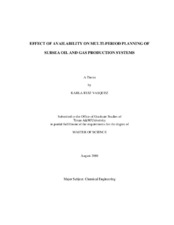| dc.description.abstract | Natural gas and petroleum are non-renewable and scarce energy sources.
Although, it is well known that hydrocarbon reserves are depleting through the years, oil
and gas remain the principal source of energy upon which our society is strongly
dependent. Hence, optimization and accurate planning of hydrocarbon production are
the main keys to making it safer, more efficient, and cheaper. One of the tools
commonly used to evaluate the optimization of oil/gas production system is the process
simulation modeling.
A hydrocarbon production system typically consists of at least one underground
reservoir where several wells have been drilled into the hydrocarbon-bearing rock to
form a fixed topology network. Wells are interconnected with manifolds to transport the
gas or oil to a storage or sale location. The process simulation consists of calculating the
total hydrocarbon production for the given production system. The pressure in the
wellbore is the main variable in determining the hydrocarbon production process. When
oil/gas is produced, the pressure decreases until production cannot be sustained. If the
well is shut down, the pressure at the wellbore increases because of the natural gas flow
coming from the reservoir. In addition, artificial lift techniques, such as water injection,
gas lift and pump systems can be incorporated into the simulation program. The oil/gas
production has been also modeled as a multi-period optimization case to incorporate the
possibility of different demands, cost and overall time behavior. The current field optimization approaches take in account the availability in a
general way, adding to the planning a lot of uncertainty. The proposed study includes a
suitable analysis of the likelihood of equipment failure, which will predict the
availability of the equipment in a certain period of time to perform a more accurate
planning.
In this work, we have integrated the availability analysis to the model described
above. The availability of a system is analyzed by Monte Carlo simulation, which
involves the modeling of the probabilities of failure, the type of failure, the time to repair
associated with each failure, and time of occurrence for a field system.
The availability model performed reduces significantly the uncertainties on a
multi-period planning production of either oil or gas, predicting the probability of failure
and the downtime related to the hydrocarbon production through its lifetime.
In this study, the unavailability of the equipment was quantified, reporting a
subsea equipment downtime of approximately 7%. As a result, new production planning
is accomplished in the effective work period, which will be beneficial in financial risk
decisions such as a government’s deliverability contracts. | en |


